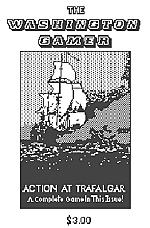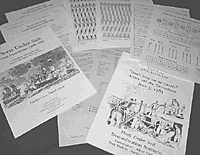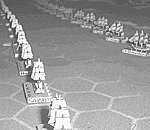 Armaments Chapter Two Verses Nine to Twenty-one: And St. Attila raised the hand grenade up on high, saying: “O Lord, bless this thy hand
grenade that with it thou mayest blow thine enemies to tiny bits, in thy mercy.” And the Lord spake, saying: “First thou shalt take out the Holy Pin, then shalt thou count to three, no more, no less. Three shall be the number thou shalt count, and the number of the counting shall be three. Four shalt thou not count, neither count thou two, excepting that thou then proceed to three. Five is right out. Once the number three, being the third number, be reached, then lobbest thou thy Holy Hand Grenade of Antioch towards thy foe, who being naughty in my sight, shall snuff it.” Amen.
Armaments Chapter Two Verses Nine to Twenty-one: And St. Attila raised the hand grenade up on high, saying: “O Lord, bless this thy hand
grenade that with it thou mayest blow thine enemies to tiny bits, in thy mercy.” And the Lord spake, saying: “First thou shalt take out the Holy Pin, then shalt thou count to three, no more, no less. Three shall be the number thou shalt count, and the number of the counting shall be three. Four shalt thou not count, neither count thou two, excepting that thou then proceed to three. Five is right out. Once the number three, being the third number, be reached, then lobbest thou thy Holy Hand Grenade of Antioch towards thy foe, who being naughty in my sight, shall snuff it.” Amen.
This game is definitely a Holy Grail. Fewer than 50 copies were published, and it was designed by Dr. Albert C.E. Parker who is very well acquainted with the subject matter. This game is also a Berg’s Paradox ... it is so rare that most collectors are blissfully ignorant of it and would not pay very much for it. This article was written by Tom Ciampa, another ex-editor of the Strategy Gaming Society newsletter Strategist, and I am most pleased to welcome him back. -ed.
 Game Design & Development
Game Design & Development
Albert C.E. Parker
Cover Illustration: Benjamin Butterfield
Counter Art: Albert C.E. Parker
Published: The Washington Gamer, Washington DC, Dec. 1991 (Issue 121).
Playtesters: Benjamin Butterfield; Steve Cabral; Mark Campbell; Thomas Ciampa; Robert Cunningham; Jay Dragonetti;
Richard Fancher; Michael Friend; John Kolb; Carl Nogueira; Mac Willingham.
Game Components
1 11” x 17” game map
1 20-page rules folder
100 Counters, printed on color bond paper, with instructions for cutting & mounting (some are two-sided)
1 Combat Results Table
1 Movement and Maneuver Table
1 Set of Figures amplifying rules on formation, facing, arc of fire, ranges, etc
1d6 is required for play
Game Components
Action at Trafalgar began development under the title Action off Cadiz, named after the Spanish port near which the Battle of Trafalgar took place on October 21, 1805. Its designer, Albert Parker, intending to provide a more familiar recognition of the subject, changed the title before final publication. It is worthy to note this because conscientious collectors may run across one of the early playtest editions with the Cadiz title.
As stated in its introduction, Action at Trafalgar is a simulation of historical and hypothetical battles of the six-month campaign ending with this, perhaps, most famous naval battle of the age of sail. It is designed at a scale of three ships per counter. Most naval sail games concentrate on the maneuvers of individual ships. This game, however, focuses upon the squadron and fleet tactics. It is interesting, and important to note that Albert deliberately set out not to design a six-direction game, and to quote him in a letter he wrote me following playtesting: “If someone had asked me to, I would have declined.”
Action at Trafalgar employs a 12-direction movement system, which is one of the features which differentiates it from other fleet action games like SPI’s Frigate (1974) and Simulations Canada’s Man of War (1983). It was published in Issue No. 121 of The Washington Gamer, December 1991. Additional scenarios for the game and an addenda to the system were published in subsequent issues of The Washington Gamer (No. 122, February 1992; and No. 124, July 1992).
Action at Trafalgar, as published, was never intended to be more than a developmental stage on the way to a commercial game that would simulate naval combat from 1652 to 1815. Regrettably however, that goal was never achieved. Now having stated the foregoing, this originally-intended simple review of an obscure little game becomes complicated by two relatively recent developments.
First, Albert subsequently embarked upon the design of a larger project over the past several years which he calls Fleets Under Sail (FUS). FUS was to continue the concept of a system permitting small groups of players to reenact the fleet actions of the period from the War of the Grand Alliance to the Battle of Navarino, and would be the design that would correct and improve upon the initial AAT prototype. He felt that the original game presented system flaws which were difficult to overcome.
The second complication of my “simple” review is, interestingly, the very latest development in the design saga of Action off Cadiz/Action at Trafalgar/Fleets under Sail. When Albert completed AAT he was aware of certain deficiencies and set out to correct them in FUS and did not seek further publication of AAT beyond The Washington Gamer. Having encountered some challenges in making the latter a playable game, he now considers AAT to be a pretty good design, recognizing the limitations of its scale. He prefers the more detailed FUS concept, but now thinks AAT would be worth publishing. He is currently engaged in updating it with some additional ideas originally developed for FUS. So both designs have contributed to each other.
In the light of this latest information, this review describes the original game followed by a brief description of the successor, FUS, together with insights straight from the designer with regard to both efforts. I also bring news of hope for a renewed initiative to refine the system for large fleet actions under one name or the other, and perhaps eventually, see its commercial publication after all.
Action at Trafalgar (AAT)
Playing Surface: A map divided into hexagons at two different scales to regulate movement. The game was designed for cardboard counters. However, Albert has given some thought to how one might employ miniatures. The ship models would have to be very small (smaller than 1:2000) unless you have a lot of playing space. It might work to mount three models in a row on a square base, or three side-by-side on a square base. Two full sets would be needed for a scenario, using the three-in-a- row sets for divisions in “line ahead” formation and the side-by-side sets for divisions in the “line abreast” formation, which are represented by opposites sides of the back-printed counters.
Game Scale: There are two scales, maneuver scale representing 1000 yards or meters across used for maneuvering fleets from the point they first come in contact, and combat scale representing 500 yards or meters across, and employed to “zoom in” when actual combat begins once contact between fleets is made.
Fleets and Counters: All the ships belonging to one side in a game constitute a “fleet”. Counters are either divisions representing a group of capital ships or single-ship counters representing detached or other odd ships. Other bookkeeping counters are used to mark wind direction, command structures, melees and other situations which arise.
Sequence of Play:
- Weather Determination Phase
- Movement Sequence Determination Phase (based upon choice by player with initiative)
- First Player Movement Phase
- Second Player Movement Phase
- Combat Phase
Formations are an important concept and may be either line ahead or line abreast. Directions and Courses: Wind directions and ship courses employ a 12-direction movement system. Division counters face either a hex intersection or side.
Stacking: Up to two division counters per hex at maneuver scale, and one division per hex at combat scale. Up to eight single ships may be stacked in maneuver scale and four in combat scale. There are rules for single ships joining and forming divisions as well as a whole array of provisions governing stacking between different fleets, the order of stacking, and positions within hexes or on hexsides or both.
Movement: A movement allowance is permitted each unit depending upon its attitude to the wind, a concept typical of Age of Sail games. Movement in AAT also includes rules for movement in hexes and on hexsides, formation effects upon turning, eligibility and mechanism for turning in succession, and effects of fleet organization and turning in succession.
Melee: The melee rules simulate the problems involved in not remaining in parallel lines. Melee does not necessarily imply that enemy crews are boarding ships. Melee is a good place to point out that the rules-writing style sometimes integrates a degree of the designer’s rationale within a rules section itself, as well as period fact. This is a concept I personally like in rules writing. It adds length, of course, but one can always skip over such comments.
Often, however, it forestalls a player’s misunderstanding of some rule that wouldn’t otherwise make sense to him. Here, in the melee section, Albert states: “Because of the hazards of attempting to pass through an enemy line or group of ships, most fighting between battle fleets since 1660 had been between parallel lines of ships.” The melee rules are quite involved, attempting as they do to recreate the chaotic realities of such an action in this period. AAT provisions for melee include types of maneuvers, forcing melee, withdrawing, stacking, determination of success, which involves effectiveness ratings, extended lines, reinforcement, and effects of its failure on movement. Melee is almost a game within the game.
Combat: During the combat phase of each turn, divisions meeting certain qualifications may engage in combat with the enemy. Units in a melee must engage in combat. A division must have an enemy division within both its range and arc of fire. Combat represents the firing of ships’ cannons and carronades as well as other types of action such as firing small arms and boarding. Single ships may not initiate combat. Formation, range and various ratings affect combat. Combat effectiveness ranges from “A”(best) to “F” (worst), representing the average skill and morale of the ships in each division.
Victory Conditions: Fleet preservation is tracked as losses taken. When a fleet’s assigned level is exceeded they must attempt to withdraw. To quote Parker: “The sailors of the era were not kamikazes, and did not fight to the last man.” A scenario may include special victory conditions for one side or both before reaching its preservation level. Command Control plays a very important role in AAT. Sail-era admirals had considerable difficulty controlling their fleets, mostly because of poor communications. To ignore this dimension of the era is to literally deceive the player about a significant challenge and obstacle faced by commanders in this period. To that end, AAT includes provisions for chain of command, admirals and flagships, position of divisions, positions of squadrons, and movement out of command.
Play Aids: Typical of this designer’s customary thoroughness, he provides numerous and detailed diagrams amplifying understanding of movement, combat, interpreting range, formations, and his 12-direction movement principles. He explains maneuver and combat scale, allowing for “sea room” on small tables or hex sheets, and illustrates the five scenarios (see the list below) which are packaged with the game with situation setup diagrams complete with miniature hex sheets showing each fleet’s location. All of this in a 5 1/2”x 8 1/2” folio format with an 11”x 17” hex sheet.
Scenario List
- 1. The Battle of Trafalgar
2. Gravina to Windward
3. Nelson’s Weakest Moment
4. Morning off Cadiz
5. Calder’s Action
Five additional scenarios were published in Issue 124 of the Washington Gamer: The Prairial Campaign, 1794
- 6. The Encounter of May 28 (9 th Prairial)
7. The Encounter of May 29 (10 th Prairial)
8. The Glorious First of June (13 th Prairial)
9. The Battle of Cape St. Vincent (1797)
10. The Battle of Camperdown (1797)
Fleets Under Sail (FUS)
 Game Design and Development: Albert C.E. Parker
Game Design and Development: Albert C.E. Parker
Fleets Under Sail components.
Game Components
1 41-Page rule book, Version 1.5.2 prepublication (under development)
1 Scenario Booklet
1 4-Page sheet with Combat Results Table, Events Table & other charts
1 Sheet containing Sequence of Play & Random Unit Selection Table
1 Game Record Card
1 4-Page Signal Booklet
9 Sets of 14 blue maneuver cards
9 Sets of 14 red maneuver cards
4 Map sheets
1 Sheet of 81 blue ship counters
1 Sheet of 81 red ship counters
1 Sheet of gray ship status counters
1 Set of wind direction and game status counters
The Differences
Both games, AAT and FUS, are attempts to design a playable game system for the great fleet actions of the Age of Sail. FUS is a lot more complicated and detailed than AAT. Here are some simple comparisons:
| Feature | Action at Trafalgar | Fleets Under Sail |
|---|---|---|
| Physical scale | 500 yds/hex & 1000 yds/hex | Has varied from 150 to 250 yds/hex |
| Unit scale | Division of 2 to 4 ships/hex | One ship/hex |
| Combat range | 2 hexes | Has varied from 4 to 7 hexes |
| Stacking? | Yes | No |
Where AAT could be published in a 5 1/2” by 8 1/2” club magazine, FUS has a rulebook of over 41 pages, and is most impressive on a large tabletop.
Says Albert about Fleets Under Sail: “It doesn’t work yet, therefore I haven’t tried to get it published.” And about Action At Trafalgar he says: “I didn’t try to commercialize it because I considered it to be a failed design. It just didn’t work because there was no way to immobilize individual ships. Unlike land warfare, where a cavalryman whose horse is dead can’t function as a cavalryman, and a soldier who can’t march can’t fight either, a ship (sail or steam) that can’t move can still shoot. Fixing that would have been a major complication and defeated the purpose of the game. I concluded that I had to stick with one ship per counter. Fleets Under Sail is the unsuccessful successor so far.”
Albert has since reconsidered this original assessment, however a deficiency this may be, and has decided that this problem alone does not completely invalidate the game system. It is a simplification that he wishes were not necessary, but it is less ahistorical than the combat systems in which whole army divisions (or other units) are either eliminated completely or unaffected by combat (in the old elim- exchange-retreat systems with no step reduction). Before seeking publication of AAT Albert plans the addition of two optional but highly recommended rules. The first is an event system that would periodically impose some limitations on the fleets or require certain units to act in ways that their omniscient commander-in- chief might not want. The other will be a provision for variations in the strength of the wind.
Conclusion:
With regard to Action At Trafalgar, this effort had, and still has, the potential for the making of a first-class commercial board or miniatures game on the subject and scale. I am completely confident in my viewpoint that one hasn’t, and is not likely ever to see, another game as comprehensively treated, extensively detailed, rich in play, focus, and insight of its historical period printed in a 5 1/2”x 8 1/2” zine. I certainly respect his self-critique that the “game doesn’t work” but can’t help wishing that he would nevertheless continue to make it available. There are among us those grognards who would pay for a copy just to experience the wealth of period detail and its concepts, and to add it to our naval game collections. I suspect that there are afficianados of the period, game tinkerers, wanna-be designers, and age of sail enthusiasts who would find the project interesting and absorbing in its current state. Certainly, the ultimate development and refined design of Albert’s current remake, Fleets Under Sail, will be the quintessential treatment of this game genre and scale of action. Consequently my wish also extends to a future opportunity for publication of Fleets Under Sail as either a magazine game or individually published version. I hope that those of us who are interested in this period will not have to wait too much longer for a future tour de force.
Collector’s Value
Action at Trafalgar (a.k.a. Action off Cadiz) is a truly rare game. It is not listed in Pimper’s All the World’s Wargames nor in Mark Boone’s Internet Wargames Catalog. Circulation of The Washington Gamer at the time AAT was published numbered about 35 members. Extra copies would have been printed for distribution to local Washington DC hobby stores, perhaps 30 or so, and in any case not more than 75 total would have been printed. Anyone who finds an original copy on eBay will really have something, with respect to the rarity value alone. I guess one might want a copy if he were trying to collect every Trafalgar game ever designed. Even if this game is revised and reprinted in some form under the same name or a new one in the future, the original labor-of-love copies printed in the now occasionally published Washington Gamer club ‘zine will remain a rare collectible.
Support Material
For Action at Trafalgar there are, of course, the supplements (rules clarifications and additional scenarios) printed in Issues 122 and 124 of The Washington Gamer, which are as rare, or perhaps rarer, than the game issue 121 itself. For Fleets Under Sail one might contact Albert via email. Playtesters’ copies of Fleets Under Sail are available for serious playtesters for the price of photocopying its 41 pages plus shipping and postage. I hope to convince Albert to submit a brief bibliography of this other wise very rich period in a future issue of Simulacrum.
 Other Games of This Type
Other Games of This Type
(“Of this type” defined simply as tactical/ operational games of the Age of Sail)
Board Games
- Wooden Ships & Iron Men, AH 1974;
Frigate, SPI 1974;
Fighting Sail, SPI (S&T 85) 1981;
Man of War, SimCan 1983;
Close Action, CoA 1997;
Fire As She Bears, Phil C. Fry (designer and publisher) 1999 (has a website, www.fire-as-she-bears.com).
Miniature Rules Systems
- Don’t Give Up the Ship, TSR 1975;
Ship of the Line, Battleline 1976;
Back to Simulacrum Vol. 3 No. 4 Table of Contents
Back to Simulacrum List of Issues
Back to MagWeb Master Magazine List
© Copyright 2001 by Steambubble Graphics
This article appears in MagWeb (Magazine Web) on the Internet World Wide Web. Other military history articles and gaming articles are available at http://www.magweb.com